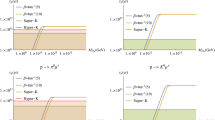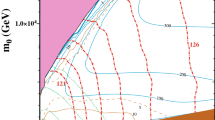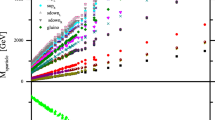Abstract
We predict the low energy signatures of a Flipped \(SU(5) \times U(1)_{\chi }\) effective local model, constructed within the framework of F-theory based on \(A_{4}\) symmetry. The Flipped SU(5) model from F Theory in the field of particle physics is prominent due to its ability to construct realistic four-dimensional theories from higher-dimensional compactifications which necessitates a unified description of the fundamental forces and particles of nature, used for exploring various extensions of the Standard Model. We study Flipped \(SU(5) \times U(1)_{\chi }\) Grand Unified Theories (GUTs) with \(A_{4}\) modular symmetry. In our model due to different modular weights assignments, the fermion mass hierarchy exists with different weighton fields. The constraints on the Dirac neutrino Yukawa matrix allows a good tuning to quark and charged lepton masses and mixings for each weighton field, with the neutrino masses and lepton mixing well determined by the type I seesaw mechanism which occurs at the expense of some tuning which manifests itself in charged lepton flavor violating decays which we explore here. The minimal Flipped SU(5) model is supplemented with an extra right-handed type and its complex conjugate electron state, \(E_{c} + \bar{E_{c}}\), as well as neutral singlet fields. The \(E_{c} + \bar{E_{c}}\) pair gets masses of the order of TeV which solves the \(g_{\mu }- 2\) discrepancy. The predictions of the model for charged lepton flavor violation decay rate and proton decay could be tested in near future experiments. Also we detect in our model the existence of neutralino, its charge mass and spin via direct and indirect detection.













Similar content being viewed by others
References
Georgianna Charalampous, Stephen F King, George K Leontaris and Ye-Ling Zhou Phys. Rev. D 104 115015 (2021)
H P Nilles, S Ramos, S Anchez and P K S Vaudrevange JHEP 02 045 (2020)
T Kobayashi and H Otsuka Phys. Rev. D 102 026004 (2020)
X G Liu and G J Ding JHEP 08 134 (2019). [arXiv:1907.01488 [hep-ph]]
I de Medeiros Varzielas, S F King and Y L Zhou Phys. Rev. D 101 055033 (2020). [arXiv:1906.02208 [hep-ph]]
G J Ding, F Feruglio and X G Liu JHEP 01 037 (2021). [arXiv:2010.07952 [hep-th]]
H Georgi and S L Glashow Phys. Rev. Lett. 32 438–441 (1974)
S F King Prog. Part. Nucl. Phys. 94 217–256 (2017). [arXiv:1701.04413 [hep-ph]]
E Ma and G Rajasekaran Phys. Rev. D 64 113012 (2001). [arXiv:hep-ph/0106291 [hep-ph]]
F Bj orkeroth, F J de Anda, I de Medeiros Varzielas and S F King JHEP 06 141 (2015). [arXiv:1503.03306 [hep-ph]]
P Chen, G J Ding and S F King JHEP 04 239 (2021). [arXiv:2101.12724 [hep-ph]]
X Du and F Wang JHEP 02 221 (2021). [arXiv:2012.01397 [hep-ph]]
Y Zhao and H H Zhang JHEP 03 002 (2021). [arXiv:2101.02266 [hep-ph]]
S F King and Y L Zhou JHEP 04 291 (2021). [arXiv:2103.02633 [hep-ph]]
G J Ding, S F King and C Y Yao [arXiv:2103.16311 [hep-ph]]
G J Ding, S F King and J N Lu. [arXiv:2108.09655 [hep-ph]]
Kalpana Bora and Gayatri Ghosh Charged Lepton Flavor Violation \(\mu \rightarrow e \gamma\) in \(\mu\)-\(\tau\) Symmetric SUSY SO(10) mSUGRA, NUHM, NUGM and NUSM Theories and LHC Eur. Phys. J. C 75 428 (2015)
Gayatri Ghosh, Majorana Neutrinos and Clockworked Yukawa Couplings Contribution to Nonobservation of the Rare Leptonic Decay \(l_{i} \rightarrow l_{j} + \gamma\), Clockwork Photon and Clockwork Graviton, LHEP 2023 351 (2023). Contribution to: NuFact2022
J Ellis, Garcia, Nagata, D V Nanopoulos and K A Olive Proton Decay: Flipped vs Unflipped SU(5) JHEP 05 021 (2020)
K Hamaguchi, S Hor and N Nagata R Symmetric Flipped \(SU(5)\)JHEP 11 140 (2020)
Gayatri Ghosh Non zero \(\theta _{13}\) and \(\delta _{CP}\) phase with \(A_{4}\) flavor symmetry and deviations to tri bi maximal mixing via \(Z_{2}\times Z_{2}\) invariant perturbations in the neutrino sector Nucl. Phys. B 979 115759 (2022)
Gayatri Ghosh Significance of Broken \(\mu -\tau\) Symmetry in correlating \(\delta _{CP}, \theta _{13}\), Lightest Neutrino Mass and Neutrinoless Double Beta Decay Adv. High Energy Phys. 2021 9563917 (2021)
M Cvetic and L Lin TASI Lectures on Abelian and Discrete Symmetries in F theory PoS TASI 2017 020 (2018)
J J Heckman, A Tavanfar and C Vafa The Point of \(E(8)\) in F theory GUTs JHEP 1008 040 (2010)
R Blumenhagen Gauge Coupling Unification In F-Theory Grand Unified Theories Phys. Rev. Lett. 102 071601 (2009)
G K Leontaris and N D Tracas Gauge coupling flux thresholds, exotic matter and the unification scale in F SU(5) GUT Eur. Phys. J. C 67 489 (2010)
G K Leontaris and Q Shafi Phenomenology with F-theory SU(5) Phys. Rev. D 96 066023 (2017)
S Cecotti, M C N Cheng, J J Heckman, C Vafa and Yukawa Couplings in F-theory and Non-Commutative Geometry
F Marchesano, D Regalado and G Zoccarato Yukawa hierarchies at the point of E8 in F theory JHEP 04 179 (2015)
M Mehmood, M U Rehman and Q Shafi Observable proton decay in flipped SU(5) JHEP 02 181 (2021)
N Sakai and T Yanagida Proton Decay in a Class of Supersymmetric Grand Unified Models Nucl. Phys. B 197 533 (1982)
B Abi et al [Muon g\(-\)2], Measurement of the Positive Muon Anomalous Magnetic Moment to 0.46 ppm Phys. Rev. Lett. 126 141801 (2021)
G Belanger, F Boudjema, P Brun, A Pukhov, S Rosier-Lees, P Salati and A Semenov Indirect search for dark matter with micrOMEGAs2.4 Comput. Phys. Commun. 182 842–856 (2011)
Eric Kuflik(Michigan U., MCTP), Joseph Marsano(Chicago U., EFI) Sep, JHEP 03 020 (2011). arXiv:1009.2510 [hep-ph]
Vasileios Basiouris, George K Leontaris(Ioannina U. and CERN), Eur. Phys. J. C 82(11) 1041 (2022). arXiv:2205.00758 [hep-ph]
Georgianna Charalampous, Stephen F King, George K Leontaris and Ye-Ling Zhou Phys. Rev. D 104 115015 (2021). arXiv:2109.11379 [hep-ph]
Vasileios Basiouris and George K Leontaris Eur. Phys. J. C 82 1041 (2022). arXiv:2205.00758 [hep-ph]
Stephen F King, George K Leontaris and Ye-Ling Zhou JHEP 03 006 (2024). arXiv:2311.11857 [hep-ph]
Jing Jiang, Tianjun Li and Dimitri V Nanopoulos Nucl. Phys. B 830 195–220 (2010). arXiv:0905.3394
K Abe et al [Super-Kamiokande], Search for proton decay via \(p \rightarrow e^{+} \pi ^{0}\) and \(\mu \rightarrow e^{+} \pi ^{0}\) in \(0.31 \,\text{ megaton }\cdot \text{ years }\) exposure of the Super\(-\)Kamiokande water Cherenkov detector Phys. Rev. D 95 012004 (2017). [arXiv:1610.03597 [hep-ex]]
K Abe et al. [Hyper-Kamiokande], Hyper-Kamiokande Design Report. [arXiv:1805.04163 [physics.ins-det]]
Acknowledgements
GG would like to thank would like to thank University Grants Commission RUSA, MHRD, Government of India for financial support to carry out this work. This work has been presented in arXiv in Cornell University which has arXiv id 2307.09948. This work has been cited in Research Square.
Author information
Authors and Affiliations
Corresponding author
Additional information
Publisher's Note
Springer Nature remains neutral with regard to jurisdictional claims in published maps and institutional affiliations.
Appendix A: \(SU(5)\times U(1)\) Symmetry
Appendix A: \(SU(5)\times U(1)\) Symmetry
In our pursuit of understanding the flipped \(SU(5)\times U(1)\) model within a generic F-theory framework, we adopt the spectral cover approach and introduce fluxes along U(1) factors to elucidate the geometric properties of matter curves and the massless particle spectrum associated with them. Through this comprehensive analysis, we successfully identify the presence of three generations of chiral matter fields and ascertain the requisite Higgs representations necessary for breaking the symmetry, thereby establishing a robust foundation for further investigations into the model’s low-energy implications and phenomenological predictions. Within each family, the chiral matter fields form a comprehensive 16 spinorial representation of SO(10), amenable to the insightful \(SU(5)\times U(1)_{\chi }\) decomposition [36, 37].
Consequently, the Standard Model representations find their embedding as follows:
The spontaneous breaking of the flipped SU(5) symmetry unfolds through the utilization of a pair of accommodated Higgs fields.
The representation of the MSSM Higgs doublets as fiveplets can be traced back to their origin within the SO(10) group’s 10-dimensional representation.
This \(U(1)_{\chi }\) charge assignment not only distinguishes between the Higgs \(\bar{5_{-2}}\) fields and the matter anti-fiveplets \(\bar{5_{-3}}\) in the flipped model, but it also plays a crucial role in generating fermion masses through \(SU(5)\times U(1)_{\chi }\) invariant couplings. The generation of fermion masses is attributed to the interaction terms involving \(SU(5) \times U(1)_{\chi }\) invariant couplings.
Notably, the GUT-scale predictions of the flipped model establish a distinct relationship between up-quark and neutrino Dirac mass matrices, characterized by \(m_{t} = m_{\nu _{D}}\). However, contrary to the standard SU(5) model, the flipped model introduces a disparity in the origins of down quark and lepton mass matrices due to their dependence on separate Yukawa couplings. Shifting focus to the Higgs sector, the acquisition of significant vacuum expectation values (VEVs) by H and \({\bar{H}}\) of the order MGUT induces the breaking of \(SU(5) \times U(1)_{\chi }\) to the Standard Model gauge group, while simultaneously conferring substantial masses upon the color triplets, as evidenced by the ensuing mass terms.
Furthermore, an additional higher-order term responsible for imparting Majorana masses to right-handed neutrinos takes the following form:
Rights and permissions
Springer Nature or its licensor (e.g. a society or other partner) holds exclusive rights to this article under a publishing agreement with the author(s) or other rightsholder(s); author self-archiving of the accepted manuscript version of this article is solely governed by the terms of such publishing agreement and applicable law.
About this article
Cite this article
Ghosh, G. FCNCs, proton stability, \(g_{\mu } - 2\) discrepancy, neutralino cold dark matter in flipped \(SU(5) \times U(1)_{\chi }\) from F theory with \(A_{4}\) symmetry. Indian J Phys (2024). https://doi.org/10.1007/s12648-024-03174-8
Received:
Accepted:
Published:
DOI: https://doi.org/10.1007/s12648-024-03174-8




